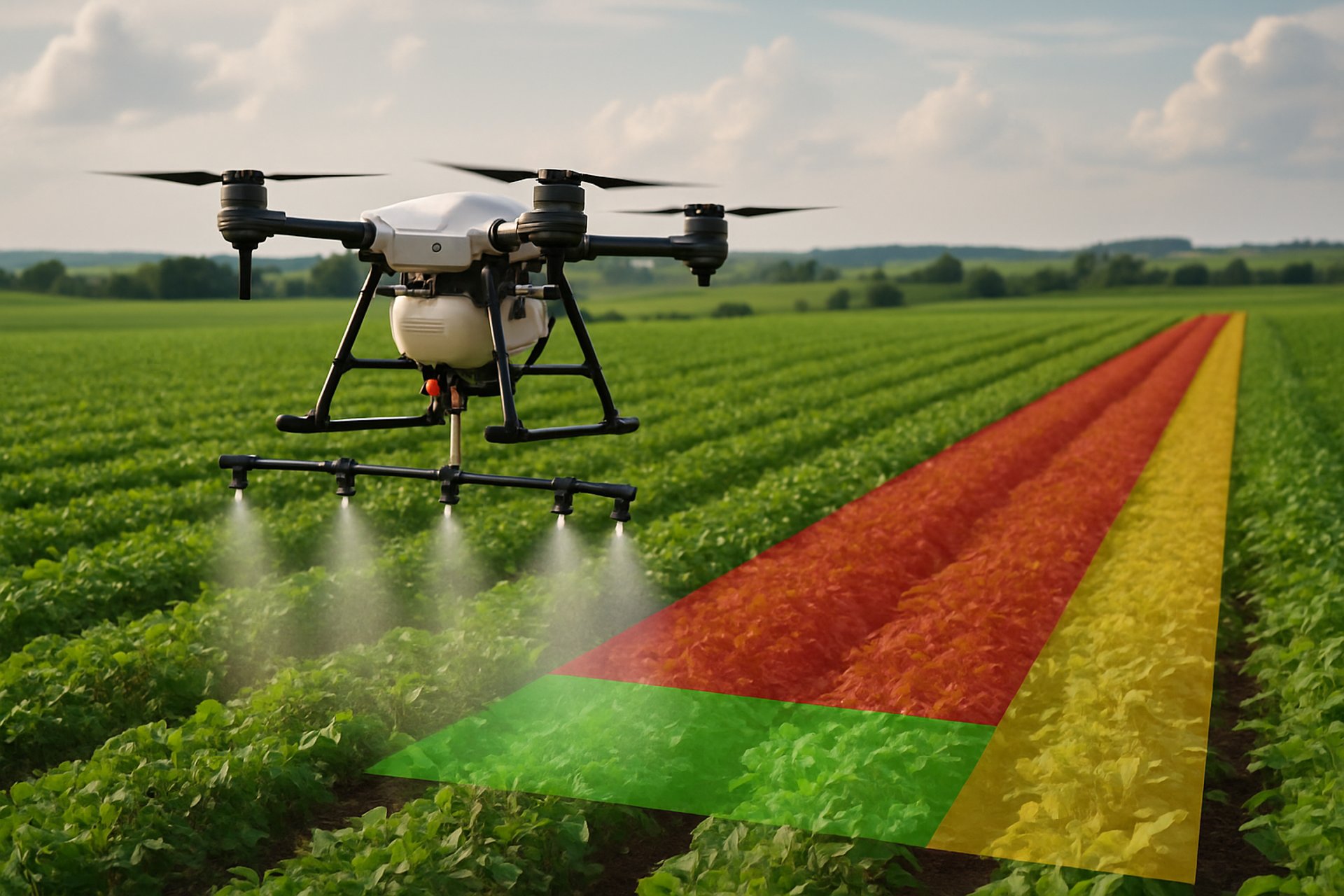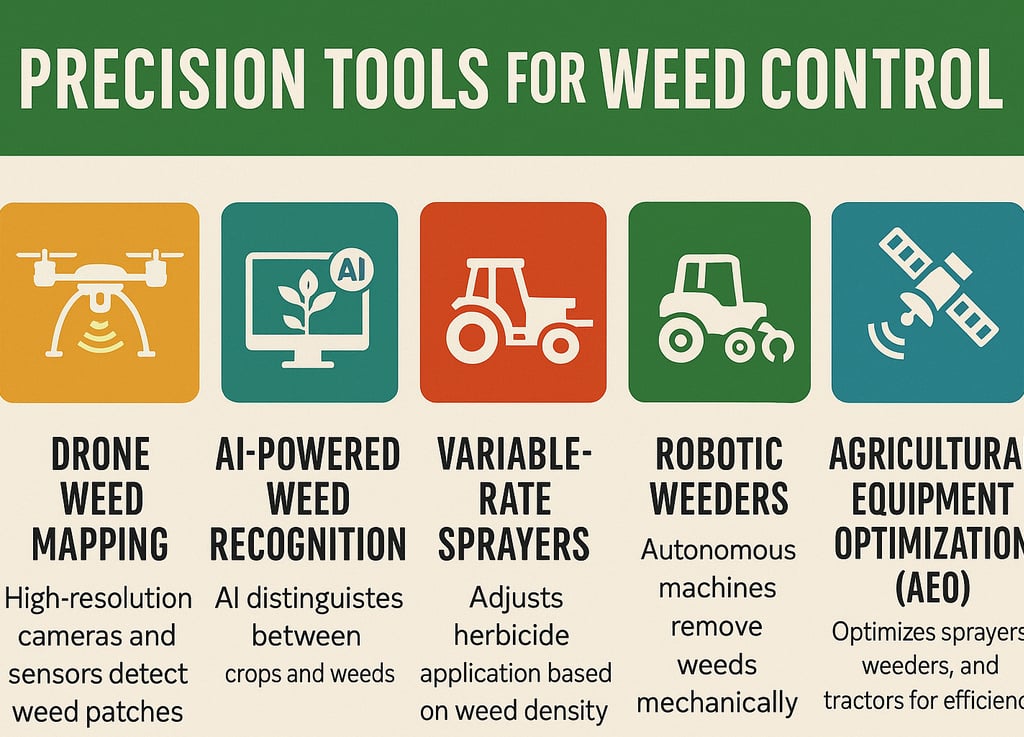🌿 GROWPlantWell – Nurture Nature, Transform Your Space 🌿

Precision Tools for Weed Control: Smarter Farming for a Weed-Free Future
Boost your farm’s productivity with precision weed control tools that optimise equipment use, reduce fuel and chemical costs, and extend machinery lifespan for sustainable farming.
Rashid Saleem
8/8/20256 min read


Why Precision Weed Control Matters Now
Weeds are a persistent challenge in agriculture, robbing crops of nutrients, water, and sunlight — ultimately hurting yields and profits. Traditional weed management often involves spraying entire fields or multiple mechanical passes, which leads to:
Excessive use of herbicides and chemicals
Increased fuel consumption and greenhouse gas emissions
Accelerated wear and tear on tractors, sprayers, and cultivators
Higher labour costs and longer field operation times
As farms grow larger and input costs rise, the need for smarter, more efficient weed control methods becomes critical. This is where precision tools step in to revolutionise weed management — helping farmers save time, money, and protect their equipment.
What Is Agricultural Equipment Optimisation in Weed Control?
Agricultural equipment optimisation means getting the maximum efficiency, lifespan, and output from your machinery. Precision weed control tools enable this by reducing unnecessary use, limiting wear, and streamlining operations.
Optimised equipment use results in:
Lower fuel and maintenance costs
Fewer breakdowns and downtime
Increased productivity and operator comfort
More sustainable farm operations with less environmental impact
Precision Tools That Optimise Your Weed Control Equipment
1. Camera-Guided Weed Sprayers
How they work:
Mounted on sprayers, these cameras scan the soil surface in real time to detect weeds. They activate individual nozzles to spray herbicide only where weeds are present.
Equipment optimisation benefits:
Cuts herbicide use by up to 90%, reducing chemical load on pumps and nozzles.
Fewer refills and shorter spraying times reduce tractor engine hours and fuel consumption.
Less wear on sprayer components extends maintenance intervals.
Real-life example:
Farmers using WEEDit® systems report cutting spray rig operation times by 30%, significantly lowering fuel use and maintenance costs.
2. AI-Powered Weed Identification Systems
How they work:
These systems use machine learning models trained on thousands of images to distinguish crops from weeds instantly, allowing precise spot spraying.
Equipment optimisation benefits:
Reduces unnecessary spraying passes over clean areas.
Minimises pump and boom wear by operating only when needed.
Enables faster field coverage, reducing tractor run time.
Technology insight:
Some systems integrate with GPS and precision steering to automate route planning, further enhancing efficiency.
3. Robotic Weeders
How they work:
Autonomous robots equipped with mechanical weed removal tools navigate fields independently, uprooting or cutting weeds without chemicals.
Equipment optimisation benefits:
Frees tractors and sprayers for other tasks, optimising overall machinery use.
Lightweight design reduces soil compaction, protecting tractor tyres and soil structure.
Operates in various weather and lighting conditions, extending working hours.
Sustainability angle:
Robotic weeders are ideal for organic farms seeking chemical-free weed management without sacrificing equipment efficiency.
4. Drone-Based Weed Mapping
How they work:
Drones with multispectral or RGB cameras fly over fields to create detailed weed maps, identifying infestation hotspots.
Equipment optimisation benefits:
Enables targeted deployment of sprayers and cultivators only where needed.
Improves planning of spray routes, reducing overlap and fuel use.
Reduces wear by avoiding unnecessary equipment operation in weed-free zones.
Operational advantage:
Drones cover large areas quickly, providing data that can be integrated with farm management software for precision application.
5. GPS-Guided Precision Cultivators
How they work:
These cultivators use GPS guidance systems to navigate accurately between crop rows, mechanically removing weeds without harming crops.
Equipment optimization benefits:
Minimises multiple passes and overlap, reducing fuel consumption and labour.
Protects cultivator blades from unnecessary wear by limiting work to weed-infested zones.
Enables use in crops where chemical herbicides are restricted.
Economic benefit:
Farmers have reported up to 25% savings in fuel and maintenance costs using GPS-guided cultivation.
6. Variable Rate Technology (VRT): Precision Tailored to Every Square Metre
Variable Rate Technology (VRT) is a revolutionary tool that takes precision weed control to the next level by adjusting herbicide application rates on-the-fly based on real-time field data. Unlike traditional spraying, which treats entire fields uniformly, VRT customises chemical application down to specific zones, optimising both resource use and equipment operation.
How VRT Works:
Utilises prescription maps generated from drone imagery, soil tests, or sensor data to identify weed density and location.
Sprayers equipped with VRT hardware adjust herbicide rates dynamically as they move through the field.
GPS technology ensures the correct dose is applied precisely where needed, reducing waste.
Equipment Optimisation Benefits:
Reduces the volume of herbicide sprayed, lowering pump pressure and extending nozzle and pump life.
Decreases the number of refill stops, saving tractor hours and fuel.
Minimises unnecessary field passes, reducing wear on tires, engines, and sprayer components.
Enhances overall operational efficiency by speeding up spraying without compromising accuracy.
Real-World Impact:
Farmers using VRT have reported up to 30% savings in herbicide costs and 20% reductions in fuel consumption, alongside extended equipment service intervals. By applying the right amount of herbicide exactly where it’s needed, VRT not only improves weed control outcomes but also safeguards the longevity of valuable farm machinery.
Integration with Other Precision Tools:
VRT works synergistically with drone-based weed mapping, AI-powered weed detection, and camera-guided sprayers — creating a fully integrated precision weed management system that maximises equipment efficiency and farm profitability.
7. Automation and Autonomy (A/A): Next-Gen Precision and Efficiency
Automation and autonomy are reshaping weed control by enabling machines to perform tasks with minimal human input, driving efficiency and precision to new heights.
How they work:
Automation allows equipment to carry out weed control operations automatically, based on pre-set instructions or sensor feedback.
Autonomy empowers machines to navigate fields independently, make real-time decisions, and adapt to changing conditions without operator control.
Equipment optimisation benefits:
Reduces operator fatigue and labour requirements by freeing farmers to manage multiple tasks simultaneously.
Improves targeting accuracy, cutting chemical use and decreasing unnecessary wear on machinery.
Extends operational hours by allowing machines to work day and night, increasing equipment utilisation.
Minimises operator error, lowering risk of damage and maintenance costs.
Real-world examples:
Autonomous robotic weeders mechanically removing weeds without herbicides.
Automated sprayers using AI and sensors for spot spraying only when and where needed.
Integrated precision systems combining drones, AI, and autonomous vehicles for seamless weed management.
Quantifiable Benefits of Precision Weed Control on Equipment Use
Fuel savings: Up to 40% reduction due to fewer field passes and more targeted spraying.
Herbicide reduction: Often over 50%, reducing pump and nozzle wear.
Equipment lifespan: Extended by 15–30% through less intensive use.
Labour efficiency: Operators spend less time on the sprayer or tractor, reducing fatigue and increasing productivity.
Real-World Case Study
A mixed-cropping farm in Queensland adopted camera-guided sprayers and drone weed mapping technology. Within one season, they saw:
60% less herbicide applied overall
25% fewer tractor engine hours used in spraying
Sprayer maintenance costs dropped by 20%
Operator fatigue reduced thanks to more streamlined operations
These savings translated into thousands of dollars reinvested into the farm’s infrastructure.
8. Downsides and Challenges of Precision Weed Control Technologies
While precision tools like automation, autonomy, and variable rate technology offer major benefits, there are some challenges and limitations to consider:
High upfront costs: Advanced equipment and software can require significant investment, which may be a barrier for smaller farms or those with tight budgets.
Technical complexity: Operating and maintaining sophisticated systems often demands specialised training and technical skills.
Data dependency: Many tools rely on accurate, up-to-date data (from drones, sensors, or satellite imagery). Poor data quality can reduce effectiveness.
Integration issues: Combining different technologies (e.g., drones, AI, autonomous vehicles) smoothly can be complex and sometimes requires customised solutions.
Infrastructure needs: Reliable internet and GPS connectivity are essential, which may be limited in remote or rural areas.
Potential job displacement: Increased automation could reduce demand for manual labour, impacting farm employment dynamics.
Maintenance and repair: High-tech equipment may need specialised servicing, which could increase costs or downtime if local support is unavailable.
Despite these challenges, ongoing innovation, falling costs, and increased farmer familiarity are steadily overcoming barriers, making precision weed control technologies more accessible and practical each year.
Takeaway: Balancing Benefits and Challenges of Precision Weed Control
Precision weed control technologies — from camera-guided sprayers and variable rate technology to automation and autonomy — represent a major leap forward for modern farming. They offer undeniable advantages:
Cost savings: Significant reductions in herbicide use, fuel consumption, and equipment maintenance translate into better farm profitability.
Improved sustainability: Targeted applications reduce chemical runoff and greenhouse gas emissions, supporting environmentally friendly farming.
Increased productivity: More efficient equipment use and extended operating hours help farmers cover more ground in less time.
Enhanced equipment lifespan: Reduced wear and fewer unnecessary passes extend machinery life and reduce downtime.
However, these benefits come with challenges. High initial investment and technical complexity can be barriers to adoption, especially for smaller farms or those in remote areas lacking infrastructure. Integration and data quality issues may limit effectiveness, while increased automation raises concerns about labour displacement.
Overall, the future of weed control lies in balancing these technologies’ transformative potential with practical considerations. As costs decline and user-friendly systems become more common, precision weed control is poised to become a standard component of sustainable, profitable farming.
Frequently Asked Questions (FAQs)
Q1: How much can precision weed control reduce fuel consumption?
Precision weed control tools can reduce fuel use by up to 40% by minimising unnecessary passes and optimising spray routes.
Q2: Are precision weed control tools expensive to implement?
While initial investment can be significant, many farmers see a return on investment within 1-3 seasons through savings on fuel, chemicals, and maintenance.
Q3: Can precision tools work on all types of farms and crops?
Yes, there are solutions tailored for broadacre, row crops, organic farms, and more. The choice depends on farm size, crop type, and management goals.
Q4: Do robotic weeders replace tractors and sprayers completely?
Not yet — robotic weeders complement existing equipment by handling specific tasks and reducing workload, improving overall equipment efficiency.
Q5: How do drones help in weed control?
Drones provide precise weed infestation maps, enabling targeted application of herbicides and cultivation, saving time and reducing chemical use.
Q6: What maintenance benefits come from using precision weed control?
Less spraying and fewer field passes mean reduced wear on pumps, nozzles, blades, and tractor engines, extending service intervals and lowering repair costs.
Q7: How does Variable Rate Technology improve weed control?
VRT customises herbicide rates per field zone, reducing chemical use, saving fuel, and optimising equipment operation for maximum efficiency.